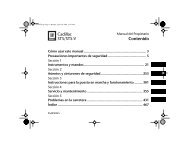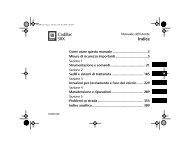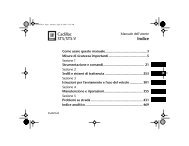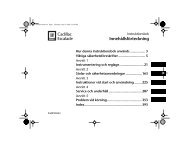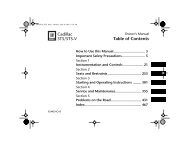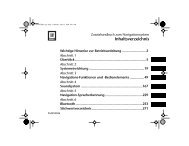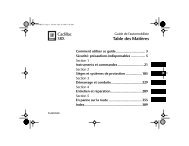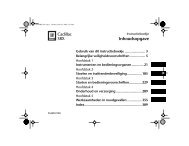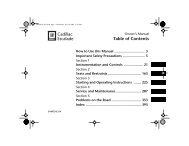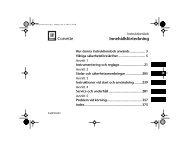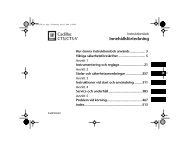Owner's Manual Cadillac BLS - IFS Europe BV
Owner's Manual Cadillac BLS - IFS Europe BV
Owner's Manual Cadillac BLS - IFS Europe BV
You also want an ePaper? Increase the reach of your titles
YUMPU automatically turns print PDFs into web optimized ePapers that Google loves.
460_OM_MY09.book Page 126 Wednesday, April 2, 2008 10:32 AM<br />
126 Starting and driving<br />
Steering wheel lock<br />
The steering wheel lock is electronic and is<br />
engaged when the remote control is withdrawn<br />
from the ignition switch. When the<br />
remote control is inserted into the ignition<br />
switch, the steering wheel lock is disengaged.<br />
A click will be heard when the<br />
steering wheel lock engages or disengages.<br />
If the car is parked with one front wheel<br />
touching the kerb, for example, you may<br />
need to turn the steering wheel slightly<br />
when you insert the remote control to allow<br />
the steering wheel lock to unlock. If you do<br />
not succeed on first attempt you must<br />
remove the remote control before trying<br />
again. Turn the steering wheel and insert<br />
the remote control into the ignition switch.<br />
If the steering wheel lock does not disengage<br />
it will not be possible to turn the remote<br />
control in the ignition switch.<br />
the following message then appears on<br />
the DIC:<br />
Pull out key, turn<br />
steering wheel. Restart.<br />
If there is a fault that may affect the function<br />
of the steering wheel lock, the following<br />
message will be displayed on the DIC:<br />
Steering lock malfunc.<br />
Make a safe stop.<br />
If the steering wheel lock malfunctions while<br />
the remote control is in the ignition switch,<br />
the lock may not engage when the remote<br />
control is removed or it may prevent the car<br />
from being restarted once the engine has<br />
been switched off.<br />
If you have to leave the car, lock the car by<br />
pressing down the lock buttons on the<br />
doors. Lock the front left door from outside<br />
with the traditional key, see page 49. The<br />
car is now locked. If the car has a car alarm,<br />
this will remain inactive.<br />
Starting the engine<br />
WARNING<br />
• When starting the engine:<br />
– Sit down in the driver’s seat.<br />
– Depress the clutch pedal fully. If the<br />
gear lever is not in the neutral position,<br />
the clutch pedal must be fully<br />
depressed or the car will jump forwards<br />
or backwards, which may<br />
cause an accident.<br />
– Never start the car from outside the<br />
vehicle, e.g. through a wound-down<br />
window. This could lead to serious<br />
personal injury.<br />
• Carbon monoxide (CO) is a colourless,<br />
odourless, noxious gas. Be<br />
aware of the danger of CO - always<br />
open the garage doors before starting<br />
the engine in a garage.<br />
• There is also a danger of CO poisoning<br />
if the exhaust system is leaking.<br />
Air may enter the lubrication system in conjunction<br />
with an oil or oil filter change. This<br />
may also happen if the car is laid up for<br />
some time.<br />
This air can cause the hydraulic tappets to<br />
emit a ticking noise, which can persist for up<br />
to 15 minutes after starting. This is quite<br />
normal and does not indicate a malfunction.<br />
It is however advisable not to exceed<br />
3000 rpm before the noise has disappeared.




